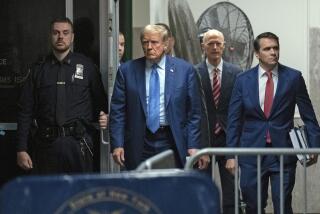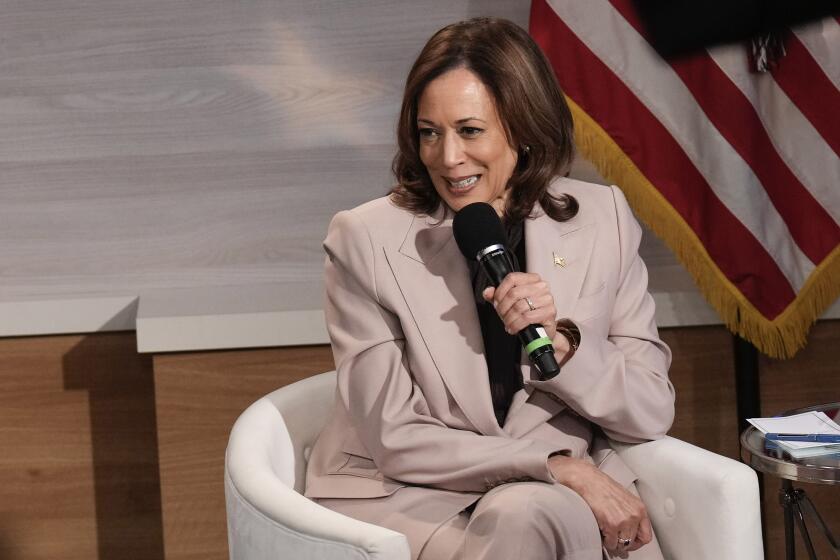With the election over, Mueller’s tempo picks up
Eighteen months into his investigation of Russian interference in the 2016 election and its possible links to President Trump, Robert S. Mueller III has retained his ability to surprise.
Repeatedly, Mueller has caught outsiders, including White House lawyers, unawares with major developments in his case. That happened again on Thursday with Michael Cohen’s guilty plea to a charge of lying to Congress.
As Trump lashed out, accusing Cohen, his former personal attorney, of lying to get a lighter sentence, Trump’s lawyer, Rudy Giuliani, insisted that Cohen’s sworn statements were consistent with the president’s. The disarray in Trump’s camp was obvious.
The week’s events reinforced a central theme of the investigation: Mueller and his team have amassed thousands of emails, tons of written records and hundreds of hours of witness testimony; White House lawyers, by contrast, have to rely heavily on what their client, the president, is willing and able to tell them.
Increasingly, Mueller knows much more than they do, and the pace of his inquiry is accelerating.
Sign up for the Essential Politics newsletter »
VERY COOL? MAYBE LEGAL
Trump’s habit of lying about matters small and large has created a constant concern for his legal team. They’ve long resisted the idea of his sitting for an interview with Mueller’s prosecutors for fear Trump would commit perjury.
Cohen’s guilty plea, as Chris Megerian wrote, at minimum exposed several more statements by Trump that were untruthful or, to be charitable, misleading.
“I have nothing to do with Russia,” Trump said at a news conference in February 2017. “To the best of my knowledge, no person that I deal with does.” That was just one of numerous times during his campaign and since that Trump insisted that he had “nothing” or “no deals” or “no business” with Russia.
In fact, right up through June of 2016, just weeks before the Republican convention, Cohen was still pursuing talks on Trump’s behalf aimed at putting a Trump tower in Moscow, he admitted in court.
Cohen said that he had lied about those talks in testimony to Congress out of “loyalty” to Trump, identified as “person number one,” in court documents.
On Thursday, Trump initially called Cohen a liar, but by Friday morning, he confirmed the essence of what Cohen said, tweeting that he had “lightly looked at doing a building somewhere in Russia.”
While he ran for president, he “continue[d] to run my business-very legal & very cool,” he wrote.
Whether that would have been cool with voters in 2016 we’ll never know — Trump clearly had doubts about that at the time since he strenuously denied then what he now admits.
Whether all was legal also remains unknown.
No law prevents a developer from pursuing a project in Moscow, even if he’s running for president. But some news reports have suggested that Cohen’s negotiations included inducements for Russian President Vladimir Putin that could have violated U.S. laws.
Moreover, Cohen’s negotiations with Russian officials took place at the same time that other Russian officials were hacking into Democratic Party computer systems, stealing emails and beginning to distribute them in an effort to help Trump’s campaign.
What Trump or others in his circle knew of those efforts remains the focus of Mueller’s probe.
MANAFORT BACK IN COURT
Earlier this week, the special counsel’s office dropped another big piece of news, accusing Paul Manafort, Trump’s former campaign chairman, of having lied to the FBI after his guilty plea.
As Chris Megerian reported, the prosecutors didn’t specify what Manafort lied about. At a presentencing hearing on Friday, they said they would file a detailed description next week. The judge presiding over Manafort’s case postponed his sentencing until early March.
Meantime, the Guardian reported that Manafort met during the 2016 campaign with Julian Assange of WikiLeaks. Manafort denied it, as did WikiLeaks.
Both the accusation against Manafort and the plea deal with Cohen came days after Trump’s lawyers submitted written answers on his behalf to a list of questions Mueller had posed. That has many legal experts wondering if Mueller was waiting to get Trump on the record before tipping his hand.
SUMMIT IN ARGENTINA
Trump left town just after Cohen’s plea, heading for the G-20 economic summit in Buenos Aires.
The center of attention there is likely to be his planned meeting on Saturday with China’s Xi Jinping. As Don Lee reported, the dinner meeting could prove a key moment in the continuing trade war between the U.S. and China.
Ahead of the talks with Xi, Trump said he won’t back down on higher tariffs. And his economic advisor, Larry Kudlow said, China “must do more.”
But Trump also signaled that he could be open to a deal that would deescalate the confrontation. At least some administration officials fear the economy is heading toward a slowdown, possibly a recession, in 2020 and don’t want Trump’s policies to take the blame.
On Friday morning, Trump met with Prime Minister Justin Trudeau of Canada and Mexican President Enrique Peña Nieto to sign the updated version of NAFTA.
As Eli Stokols and Don Lee reported, Trudeau used the signing ceremony to openly showcase the tensions between the U.S. and Canada. Peña Nieto, who was on his final day in office, was more conciliatory.
As Stokols wrote, Trump has a history of creating controversies at such international meetings.
THE BLUE TIDE RISES
In the three weeks since election day, Republican fortunes slipped from bad to worse. The latest evidence came Monday, when TJ Cox, the Democratic candidate, grabbed the lead in the nation’s last undecided House race over Republican Rep. David Valadao in California’s 21st District.
By Wednesday, as a couple of additional counties in the Central Valley district completed their count, Cox solidified his lead, giving Democrats their 40th pickup in the midterm election.
With nearly all the ballots now counted nationwide, Democratic candidates overall have amassed more than 60 million votes. That’s a huge increase over the previous record for a midterm — 44.5 million won by Republican candidates in 2010 — and indicative of the huge turnout the midterm election produced.
The Democratic edge, 53.3% of the total vote, compared with 45% for Republican candidates, is also huge. Their 8.3-percentage point lead is one of the biggest for either party since World War II. Those numbers, by the way, come courtesy of the invaluable Dave Wasserman of the Cook Political Report.
The 235 House seats the Democrats will hold in January corresponds closely to their margin in the popular vote. Gerrymandered districts held back Democratic gains in a number of state legislatures, including Wisconsin, Michigan and North Carolina, but proved less of a factor overall in congressional races.
California proved a disaster area for Republicans. At the top of the ticket, their candidate for governor, John Cox, won just over 38% of the vote — the worst showing for a major party candidate for governor in the state in 40 years.
Down the ballot, the pattern continued: Every House race that Democrats targeted ended up falling their way.
As Mark Barabak and Sarah Wire wrote, the GOP wipeout in the state has generated tough questions for the soon-to-be minority leader of the House, Rep. Kevin McCarthy of Bakersfield.
McCarthy repeatedly asked his California colleagues to vote with Trump on issues that hurt them in their districts. That helped solidify his relationship with the president, but may have contributed to at least some of the losses.
PELOSI RIDES THE WAVE
Not for nothing does Rep. Nancy Pelosi of San Francisco have a reputation as one of the savviest political players in Washington.
For a month, her opponents within the Democratic caucus claimed they had the votes to block Pelosi’s return to the speakership, but as Jennifer Haberkorn reported, when the actual votes were counted in the caucus, the anti-Pelosi faction received half as many votes as they did when they challenged her two years ago.
Pelosi still needs to win over some colleagues before the full House votes on Jan. 3, but with no declared opponent, her path seems fairly smooth.
Exactly how many votes Pelosi still needs to get remains a bit unclear. She has about 200 nailed down and needs at least a dozen more.
Winning the speakership requires a majority of the votes cast. That would be 218 if every member voted.
But at least some of those who have said they won’t vote for Pelosi on the House floor plan to abstain, which reduces the total needed. And at least one Republican seat in the House may still be vacant on Jan. 3: North Carolina’s board of elections has delayed certifying one congressional race amid reports of possible voter fraud by the Republican campaign involving absentee ballots.
Meantime, the Democrats filled several other seats in their leadership lineup. Oakland Rep. Barbara Lee lost her race to Rep. Hakeem Jeffries of Brooklyn, whom many House Democrats see as a potential future leader. As Wire wrote, Lee would have been the first black woman ever in House leadership.
And Rep. Cheri Bustos of Illinois was elected to lead the House Democrats’ campaign committee. She, along with Jeffries and Rep. Ben Ray Lujan of New Mexico, who led the Democratic election effort this year, are among the top prospects for the next generation of potential Democratic leadership.
LOOKING AHEAD TO 2020
Democrats and Republicans see costs and benefits of Trump’s MAGA rallies, Noah Bierman reported. Democrats say the rallies helped GOP candidates in some conservative areas, perhaps tipping the scales in a couple of Senate races. But Trump’s presence also spurred a higher turnout of Democratic voters.
And presidential hopefuls from the Democratic left are scrambling to figure out how to ride the blue wave, Evan Halper reported. The progressive campaigns are analyzing what worked and what didn’t in the midterm elections.
ONE BIG NEGATIVE FOR CALIFORNIA DEMOCRATS
Amid the celebrating over their election successes, California Democrats have to deal with a big internal problem — the resignation of the state party chairman, Eric Bauman, after Melanie Mason’s deeply reported article that brought to light numerous accusations of sexually explicit comments and unwanted touching.
Bauman initially said he would take a leave of absence, but on Thursday, amid calls from Gov.-elect Gavin Newsom and other top Democrats for him to leave, he resigned.
As John Myers, Phil Willon and Taryn Luna wrote, Democrats now have to figure out what went wrong to allow Bauman’s rampant misconduct to go on as he rose into the party leadership.
THE REST OF THE WEEK’S NEWS
Trump’s threats against General Motors fit a pattern: More bark than bite, Noah Bierman reported.
The number of immigrants in the U.S. illegally is the lowest in more than a decade, according to new data from the nonpartisan Pew Research Center, Jaweed Kaleem reported.
California Atty. Gen. Xavier Becerra clashed with Trump’s acting EPA chief over climate change, Halper reported.
The number of uninsured children in the U.S. increased last year, reversing more than a decade of progress, Noam Levey reported.
California’s senators ask Congress for $9 billion for wildfire recovery, Wire reported. The money could come in an end-of-the-year spending package.
The administration is preparing to extend troops’ stay on the border, even though their mission is unclear, David Cloud reported.
LOGISTICS
That wraps up this week. Until next time, keep track of all the developments in national politics and the Trump administration with our Essential Washington blog, at our Politics page and on Twitter @latimespolitics.
Send your comments, suggestions and news tips to politics@latimes.com.
If you like this newsletter, tell your friends to sign up.
More to Read
Get the L.A. Times Politics newsletter
Deeply reported insights into legislation, politics and policy from Sacramento, Washington and beyond. In your inbox three times per week.
You may occasionally receive promotional content from the Los Angeles Times.











